
4.1 DATABASE
4.1.1
CAPEC’s database for actuarial appraisal is from October 2009, and is com-posed of 152,595 participants distributed in savings by death and 14,128 participants in savings by disability, guaranteed as per Table N:
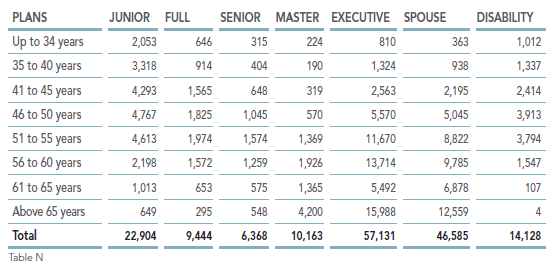
4.1.2
In 2009, 83 participants enrolled in Benefit Plan 1 and 2,037 participants enrolled in the PREVI Futuro Plan. Out of this group, 82% are younger than or equal to 40 years old. The admission of new participants is essential for CAPEC, since the average age is currently 57. This rejuvenates the portfo-lio, contributing to reduce the biometric risks of the plan.
4.2 BENEFIT PLAN
4.2.1
CAPEC is registered at the Office of Supplemental Pension Plans as a sin-gle payment benefit plan and offers the following savings:
4.2.2
For dependents or assigned beneficiaries:
- Savings for Death: as a result of the participant’s natural or accidental death, as per the mode of enrollment.
- Subsistence Savings: if the participant dies before their spouse, the latter may continue connected to the CAPEC, provided he or she continues to pay the contributions the way PREVI indicates.
4.2.3
For participants:
- Savings for Disability: as a result of labor disability which has occurred and as per the enrollment mode.
- Spouse Savings: as a result of the death of the wife or husband or of the companion, acknowledged as such under civil law, as long as properly registered in the Economic Dependent Reference file of the Banco do Brasil S.A., PREVI or of the Official Social Security System as a companion, as per the mode of enrollment.
4.2.4
CAPEC is stated in art. 3, Subparagraph IV, of the Entity’s Bylaws, which ensures “to all participants: the option of being connected to a savings plan by means of making specific contributions,” therefore, CAPEC is maintained with participant contributions and there is no employer contribution. Its fi-nancial system is that of simple distribution with annual accrual periods.
4.3 CALCULATION METHODOLOGY AND ACTUARIAL PREMISES
4.3.1
CAPEC’s revenue is calculated based on the Simple Distribution Financial System with annual actuarial appraisals, based on an ordinary actuarial cal-culation principle used for the technical constitution of temporary life insur-ance for a year with automatic annual renewals.
4.3.2
The premises used in the October 2009 actuarial reappraisal for the 2010 fiscal year were approved by the Executive Board and by the Deliberative Body. The approved premises were:
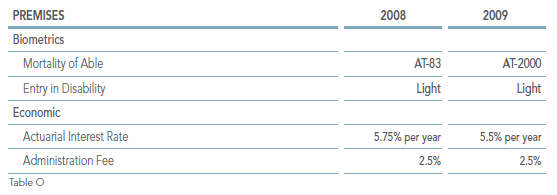
4.3.3
The mortality table changed due to a study conducted by PREVI’s actuarial area which showed that the average life expectancy of PREVI participants has increased in the last years. By analyzing mortality rates, life expectancy, and results of statistical tests, we verified that the PREVI population is best represented by mortality table AT-2000, reflecting on the calculation of con-tributions regarding Savings by Death.
4.4 FINANCIAL AND ACTUARIAL STATUS
4.4.1
Table P shows the monthly contributions in effect after 05/01/2009 that cor-respond to the amounts insured by CAPEC, considering the administration fee of 2.5% and the 10% contingency fee:
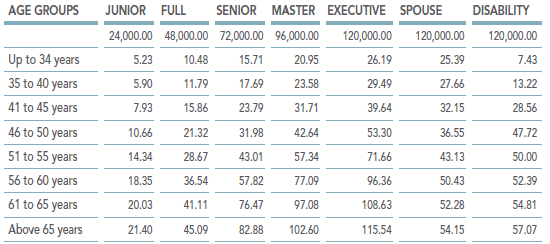
Table P - Figures in Brazilian Real (R$).
4.4.2
The monthly contributions proposed for the next year, considering the prem-ises mentioned in item 4.3.2, will take place starting April 2010, after being presented to the Executive Board and Deliberative Body.
4.4.3
The flow of contributions, from paid claims and gains with investments rela-tive to the portfolio had the following results on 12/31/2009:
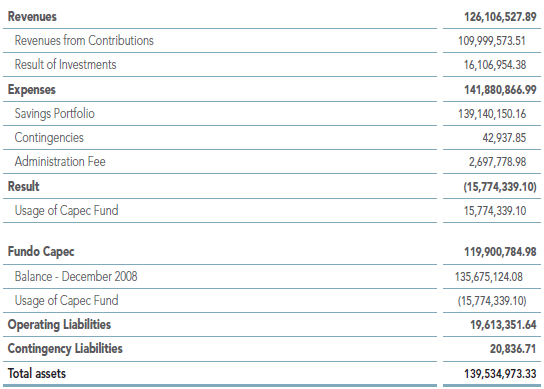
Tabela Q - Figures in Brazilian Real (R$).
4.4.4
Capec’s Social Security Fund, called Capec Fund, was constituted to en-sure the payment of savings when there are insufficient availabilities. On 12/31/2009, the balance of the Capec Fund was R$ 119,900,784.98.
4.4.5
During the year, R$15,774,339.10 of the mentioned Fund’s resources were used to subsidy contributions made by older participants in the transition from the collection via sole premiums to a collection per age group, which began in 2006. This measure was part of Capec’s Restructuring Plan, as approved in 2005 by the Executive Board and by the Deliberative Body.
4.4.6
Because of this, Capec’s total assets were reduced from R$153,350,445.31 (12/31/2008) to R$ 139,534,973.33 (12/31/2009).
4.4.7
We also entered the amount of R$19,612,086.09 for the provision of in-formed and unpaid claims by the portfolio corresponding to processes in course of liquidation.
4.4.8
The following is the evolution of the contribution’s revenues, expenses with savings, and of the Capec Fund’s amounts in the past three years:
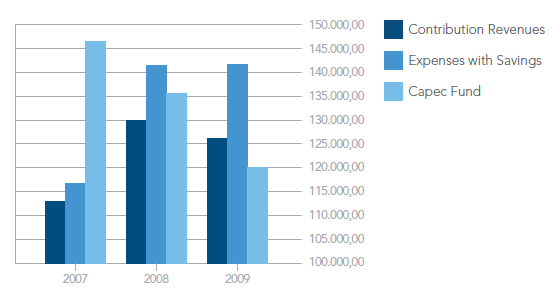
4.5 FUNDING PLAN
4.5.1
CAPEC’s funding is the responsibility of plan participants and there is no employer contribution. The amount of monthly contributions will vary accord-ing to age group and type of savings portfolio to which the participants en-rolled or contracted.
4.5.2
According to CAPEC’s Restructuring Plan, resources from the CAPEC Fund are used to subsidize monthly plan contributions. Thus mitigating funding for older age groups.
4.5.3
The following graph presents CAPEC’s performance from January to De-cember 2009:
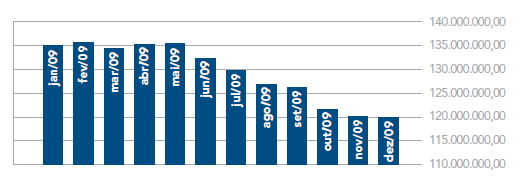
4.6 CONCLUSION
4.6.1
We observed that the CAPEC Fund underwent an accentuated reduction during the last six months. Therefore, we believe that the contributions re-garding the subsidized group should be corrected so that, by the end of the fund, there is no significant impact on the contribution values for the subsi-dized age groups.
4.6.2
In any case, we attest that the contribution amounts calculated for the Sav-ings Portfolio and the expected evolution for the commitments the plan took-on with its participants show that the actuarially premises were defined ap-propriately in the period under analysis.
4.6.3
Considering the above, we conclude the results attained by the CAPEC at the closing of the 2009 fiscal year indicate it is actuarially well-balanced, ac-cording to item 4.6.1.
Rio de Janeiro, January 28 2010.
| Cleide Barbosa da Rocha Actuary – MIBA 732 |
Dilcrécio Akira Miki Actuary – MIBA 1.959 |
